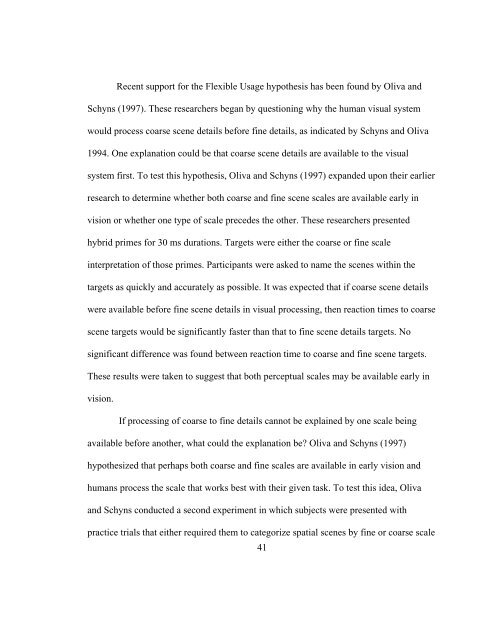The Use of Iambic Pentameter in the
The Use of Iambic Pentameter in the
The Use of Iambic Pentameter in the
Create successful ePaper yourself
Turn your PDF publications into a flip-book with our unique Google optimized e-Paper software.
Recent support for <strong>the</strong> Flexible Usage hypo<strong>the</strong>sis has been found by Oliva and<br />
Schyns (1997). <strong>The</strong>se researchers began by question<strong>in</strong>g why <strong>the</strong> human visual system<br />
would process coarse scene details before f<strong>in</strong>e details, as <strong>in</strong>dicated by Schyns and Oliva<br />
1994. One explanation could be that coarse scene details are available to <strong>the</strong> visual<br />
system first. To test this hypo<strong>the</strong>sis, Oliva and Schyns (1997) expanded upon <strong>the</strong>ir earlier<br />
research to determ<strong>in</strong>e whe<strong>the</strong>r both coarse and f<strong>in</strong>e scene scales are available early <strong>in</strong><br />
vision or whe<strong>the</strong>r one type <strong>of</strong> scale precedes <strong>the</strong> o<strong>the</strong>r. <strong>The</strong>se researchers presented<br />
hybrid primes for 30 ms durations. Targets were ei<strong>the</strong>r <strong>the</strong> coarse or f<strong>in</strong>e scale<br />
<strong>in</strong>terpretation <strong>of</strong> those primes. Participants were asked to name <strong>the</strong> scenes with<strong>in</strong> <strong>the</strong><br />
targets as quickly and accurately as possible. It was expected that if coarse scene details<br />
were available before f<strong>in</strong>e scene details <strong>in</strong> visual process<strong>in</strong>g, <strong>the</strong>n reaction times to coarse<br />
scene targets would be significantly faster than that to f<strong>in</strong>e scene details targets. No<br />
significant difference was found between reaction time to coarse and f<strong>in</strong>e scene targets.<br />
<strong>The</strong>se results were taken to suggest that both perceptual scales may be available early <strong>in</strong><br />
vision.<br />
If process<strong>in</strong>g <strong>of</strong> coarse to f<strong>in</strong>e details cannot be expla<strong>in</strong>ed by one scale be<strong>in</strong>g<br />
available before ano<strong>the</strong>r, what could <strong>the</strong> explanation be? Oliva and Schyns (1997)<br />
hypo<strong>the</strong>sized that perhaps both coarse and f<strong>in</strong>e scales are available <strong>in</strong> early vision and<br />
humans process <strong>the</strong> scale that works best with <strong>the</strong>ir given task. To test this idea, Oliva<br />
and Schyns conducted a second experiment <strong>in</strong> which subjects were presented with<br />
practice trials that ei<strong>the</strong>r required <strong>the</strong>m to categorize spatial scenes by f<strong>in</strong>e or coarse scale<br />
41

















